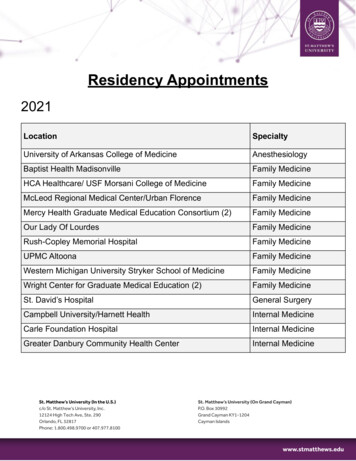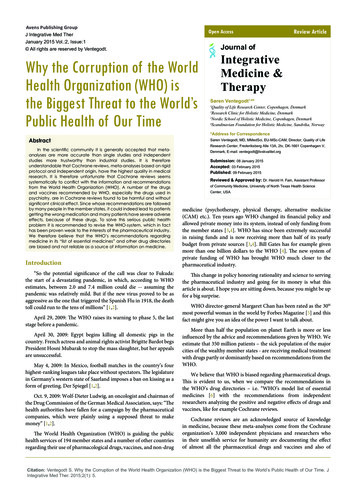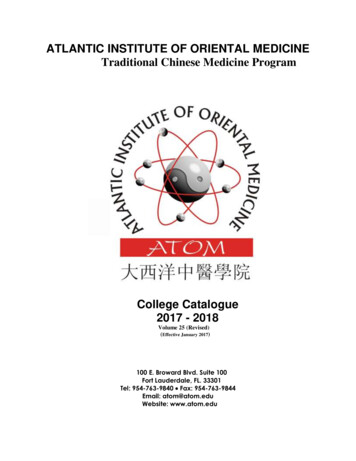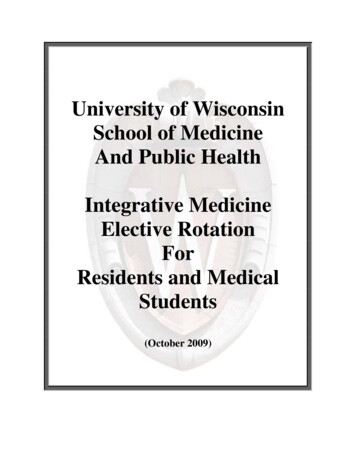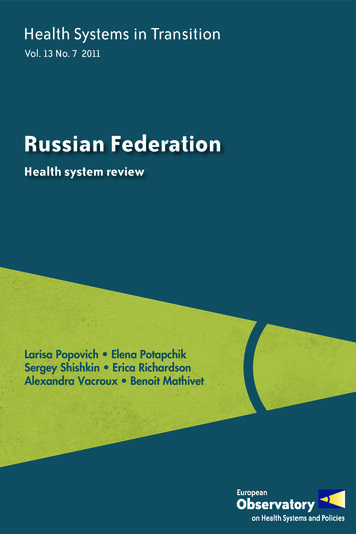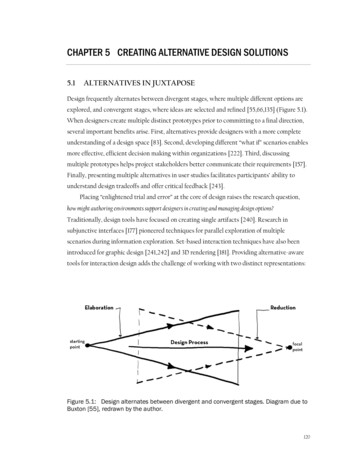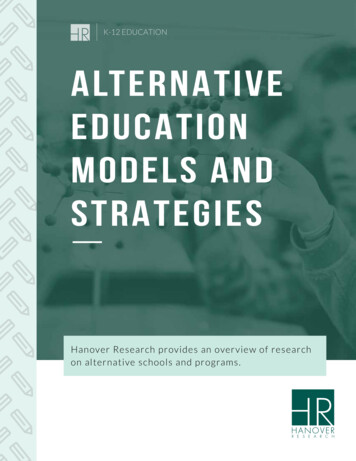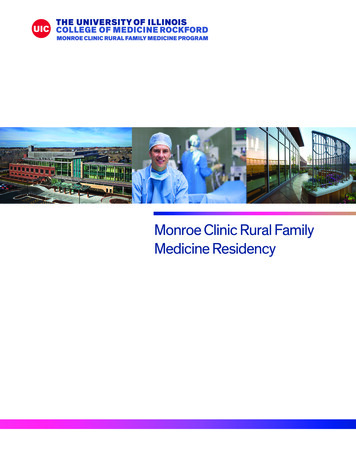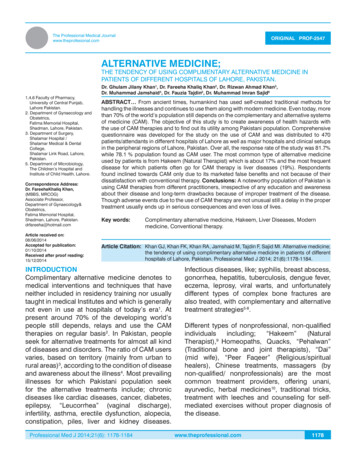
Transcription
ALTERNATIVE MEDICINEThe Professional Medical Journalwww.theprofesional.comORIGINAL PROF-2547ALTERNATIVE MEDICINE;THE TENDENCY OF USING COMPLIMENTARY ALTERNATIVE MEDICINE INPATIENTS OF DIFFERENT HOSPITALS OF LAHORE, PAKISTAN.1,4,6 Faculty of Pharmacy,University of Central Punjab,Lahore Pakistan.2. Department of Gynaecology andObstetrics,Fatima Memorial Hospital,Shadman, Lahore, Pakistan.3. Department of Surgery,Shalamar Hospital /Shalamar Medical & DentalCollege,Shalamar Link Road, Lahore,Pakistan.5. Department of Microbiology,The Children’s Hospital andInstitute of Child Health, Lahore.Correspondence Address:Dr. FareehaKhaliq Khan,(MBBS, MRCOG)Associate Professor,Department of Gynaecology&Obstetrics,Fatima Memorial Hospital,Shadman, Lahore, Pakistan.drfareeha@hotmail.comArticle received on:08/06/2014Accepted for publication:01/10/2014Received after proof reading:15/12/2014Dr. Ghulam Jilany Khan1, Dr. Fareeha Khaliq Khan2, Dr. Rizwan Ahmad Khan3,Dr. Muhammad Jamshaid4, Dr. Fauzia Tajdin5, Dr. Muhammad Imran Sajid6ABSTRACT From ancient times, humankind has used self-created traditional methods forhandling the illnesses and continues to use them along with modern medicine. Even today, morethan 70% of the world’s population still depends on the complementary and alternative systemsof medicine (CAM). The objective of this study is to create awareness of health hazards withthe use of CAM therapies and to find out its utility among Pakistani population. Comprehensivequestionnaire was developed for the study on the use of CAM and was distributed to 470patients/attendants in different hospitals of Lahore as well as major hospitals and clinical setupsin the peripheral regions of Lahore, Pakistan. Over all, the response rate of the study was 81.7%while 78.1 % population found as CAM user. The most common type of alternative medicineused by patients is from Hakeem (Natural Therapist) which is about 17% and the most frequentdisease for which patients often go for CAM therapy is liver diseases (19%). Respondentsfound inclined towards CAM only due to its marketed false benefits and not because of theirdissatisfaction with conventional therapy. Conclusions: A noteworthy population of Pakistan isusing CAM therapies from different practitioners, irrespective of any education and awarenessabout their disease and long-term drawbacks because of improper treatment of the disease.Though adverse events due to the use of CAM therapy are not unusual still a delay in the propertreatment usually ends up in serious consequences and even loss of lives.Key words:Complimentary alternative medicine, Hakeem, Liver Diseases, Modernmedicine, Conventional therapy.Article Citation: Khan GJ, Khan FK, Khan RA, Jamshaid M, Tajdin F, Sajid MI. Alternative medicine;the tendency of using complimentary alternative medicine in patients of differenthospitals of Lahore, Pakistan. Professional Med J 2014; 21(6):1178-1184.INTRODUCTIONComplimentary alternative medicine denotes tomedical interventions and techniques that haveneither included in residency training nor usuallytaught in medical Institutes and which is generallynot even in use at hospitals of today’s era1. Atpresent around 70% of the developing world’speople still depends, relays and use the CAMtherapies on regular basis2. In Pakistan, peopleseek for alternative treatments for almost all kindof diseases and disorders. The ratio of CAM usersvaries, based on territory (mainly from urban torural areas)3, according to the condition of diseaseand awareness about the illness4. Most prevailingillnesses for which Pakistani population seekfor the alternative treatments include; chronicdiseases like cardiac diseases, cancer, diabetes,epilepsy, “Leucorrhea” (vaginal discharge),infertility, asthma, erectile dysfunction, alopecia,constipation, piles, liver and kidney diseases.Professional Med J 2014;21(6): 1178-1184Infectious diseases, like; syphilis, breast abscess,gonorrhea, hepatitis, tuberculosis, dengue fever,eczema, leprosy, viral warts, and unfortunatelydifferent types of complex bone fractures arealso treated, with complementary and alternativetreatment strategies5-8.Different types of nonprofessional, uralTherapist),9 Homeopaths, Quacks, “Pehalwan”(Traditional bone and joint therapists), “Dai”(mid wife), “Peer Faqeer” (Religious/spiritualhealers), Chinese treatments, massagers (bynon-qualified/ nonprofessionals) are the mostcommon treatment providers, offering unani,ayurvedic, herbal medicines10, traditional tricks,treatment with leeches and counseling for selfmediated exercises without proper diagnosis ofthe disease.www.theprofessional.com1178
ALTERNATIVE MEDICINEThe key factors due to which people seek foralternative medicines and treatments include,high hopes in patients regarding the recoveryby treatment providers, low cast (includingno diagnostic cast) of treatment,11 mediaadvertisements with false and non-scientific claims,unethical counseling by the treatment providerscreating fear of surgery, fear of side effects, andpsychological fears in the patients, positive wordof mouth from known ones, religious believes,influence and recommendation of hospital staffmembers like (operation theater assistants, ladyhealth workers, health visitors, dispensers, etc)12.Besides these influential reasons, there are someof the health system and administration flows dueto which patients adopt alternative treatments as apreference for example; failure of empirical therapy,maltreatment/ under treatment, long duration oftreatment leading towards patient’s frustration.Patient’s internal fear of surgery because of lackof proper counseling by the physician/surgeonand lack of availability of female practitioners tofacilitate the patients with female related diseaseslike gynecological diseases13-15. Though in somecases CAM therapies have shown benefits, insoothing acute as well as chronic disorders, it isstrappingly assumed that these therapies showtheir effect of healing through their stimulus onthe immune system of the human body16.MATERIAL AND METHODA cross-sectional, interview based survey wasconducted in the period of 8 months (March toOctober 2013) in different hospitals of Lahore,as well as major clinical setups in the peripheralregions, covering the patients reported athospitals like Shalimar and Fatima Memorialhospital, and patients reported at medical centers/clinical setups of different towns and villages,were interviewed/surveyed . Out of twenty seven,22 questions were close ended and 5 questionswere of open ended type.Inclusion CriteriaPatients of age ranging from 18 to 60 years withboth genders who used CAM treatments in pastwere included in the study.Professional Med J 2014;21(6): 1178-11842Patient’s consent fromDetailed and properly informed consent was takenfrom patients and communication language forthe discussion was Urdu and Punjabi for detaileddiscussion.Patient intakeA total of 384 patients were selected from differentdisciplines of hospitals including Surgical OPD,Medicine OPD, Gynecology OPD and OrthopedicOPD. These patients were properly examinedby the competent clinicians and gynecologists.Upon taking history of these 384 patients, 300patients confirmed that they were using differentCAM therapies.Data Collection tools and analysisQuestionnaire was planned based on studyobjectives, taking help from the previous worksand studies accessible on the topic added withcontent specific questions. The questionnaire wasorganized after preliminary conversation with fewpatients and thorough considerations of healthprofessionals who were also up-to-date regardingthe use of CAM therapy. The questionnaire wasdivided in two portions, first dealing with thedemographic profile of subjects such as age, sex,marital status, socioeconomic status, and highestlevel of education attained and second consistedof the questions regarding the knowledge andawareness about different aspects of alternativetreatments.Patient historyIn our questionnaire we requested the patientsand different individuals about their demographicinformation and asked them if they had usedalternative medicine in their life span or notand upon a positive answer we further askedthem to participate in the study by providing theinformation regarding their experience with theuse of CAM therapy.Ethical permissionThe respondents were assured of the confidentialnature of this survey, and were given the right tohide or show their names upon their own wish.www.theprofessional.com1179
ALTERNATIVE MEDICINEStatistical analysisSPSS 16 software was used for organizing thedata that was collected at the end of survey.RESULTSA total of 470 questionnaires were discussedand distributed in Hospitals of Lahore (Shalamar,Fatima Memorial), and medical centers in theperipheral regions of Lahore. Out of these 470supplies, 384 returned the survey questionnaireswith complete response, the overall response rateis of 81.7% (384/470). Out of 384, 300 patientsconfirmed the use of alternative treatments, soamong the respondents we found that 78.1%(300/384) population of Lahore is using the CAMtherapy in which the share of female population isaround 72 %, moreover 61 % population is eitherhaving an education level of less than primary orentirely no education. Interestingly 81% of thesurvey respondents were married while 58.7%had a monthly income of less than 10,000.3midwifery techniques by “Dai” (mid wife) are alsofound in many patients as a major CAM therapyand its overall proportion is around 11 %(TableI,figure 1).Previous TreatmentFrequencyPercentageSurgery20.7Herbal treatment3010.0Homeopathic treatment4314.3Religious treatment289.3Hakeem(Natural therapist treatment)5117.0Midwifery tricks3311.0Chinese herbal treatment2.7Unknown medicine fromlocal individual (quack)3210.7Massage therapies3612.0Pahalwan’s treatment (boneand joint quacks)155.0Total300100.Table-I. Previous treatment typesPatients use CAM therapies for a widespreadrange of illnesses and critical circumstances(Table II, figure 2). The most common conditionsreported, were liver diseases (19%), followedclosely by gynecological disorders including“Leucorrhea” (Vaginal Discharge) and pregnancyrelated problems (15%), where as diabetes anderectile dysfunction found to have a share ofaround (14%) for which people often adopt CAMtherapies. Unfortunately complex bone injuriesand bone fractures are also being treated by theCAM practitioners (12%), which often lead to alifetime disability.Figure-1. Previous treatments received by patientsFrom our study, we found that patients in theage group of 46- 53 years are more significantlyinvolved in the use of CAM therapy and the mostfrequent types of alternative medicine used bypatients are from “Hakeem” (natural therapist),homeopaths, massage therapists, midwifery andherbal medicine (Table 1, figure 1). 17% of patientswho used alternative medicine said they wereused to go to “Hakeem” (Natural Therapist) and14.3% had gone through homeopathic treatment,Professional Med J 2014;21(6): 1178-1184The usual disorders for which patients use bothCAM therapies and allopathic treatments bytraditional physician are diabetes, tuberculosis,and kidney diseases. Almost 61% of these patientswere in the late phase of their diseases whenthey visited their qualified physician/surgeon orgynecologist for the first time. (Table II, Figure 2).45.2% of CAM users stated that they did not visitany medical practitioner for the illness againstwhich they were using alternative medicine.www.theprofessional.com1180
ALTERNATIVE MEDICINE4Figure-2. Most Used CAM s and erectiledysfunction4214.0Gynecological and femalerelated disorders4515.0Infertility and child gender3311.0Complex injuries and bonefractures3512.0Liver disease jaundice andhepatitis5719.0Constipation and piles41.3Epilepsy62.0Asthma62.0Alopecia93.0Kidney diseases93.0Syphilis31.0Breast abscess62.0Gonorrhea93.0Tuberculosis51.7Dengue fever103.3Cardiac disease31.0Cancer20.7Eczema31.0Leprosy31.0Viral warts93.0Total300100.0Stage of diseasesInitial279.0Middle9030.0Later14749.Extreme late3512.0Table-II. Previous treatment typesProfessional Med J 2014;21(6): 1178-1184It is quite noticeable that when CAM usersrequested to select from a list of possible aims forusing the CAM therapy nearly one fourth (22.3%)of the patients responded as they are unable toafford the cost of allopathic treatments, on theother hand 19% of the patients are using CAMtherapy due to unavailability of medical facilitiesat their towns and villages while 23% werethose who used to do everything to fight againsttheir disease and they thought that these CAMtherapies were more effective for their problems.However majority of the respondents chose CAMtherapies due to its claimed benefits and notbecause of their dissatisfaction with scientific andtraditional allopathic treatment or with qualifiedphysician or hospital system.Of the 300 confirmed users of alternativemedicines, 60% are using these treatmentsoccasionally however 32 % patients are dailyusers of CAM therapy. One of the major reasonsof patient satisfaction with the use of CAM therapyis its less possibility of causing any unwantedeffects, in our studies 84 % patients confirmedthat they never observed any unwanted effectsfrom the therapy (Table III).Out of 300 CAM therapy using respondents 54.7%did not experience any benefit from therapy, 86.7%were not agreed to continue this treatment dueto no significant benefits from these alternativetreatments whereas 13% were very satisfied fromthese treatments (Table III).DISCUSSIONIn Pakistan, more than half of the residents (66%)live in villages17. Poverty, compounded by illiteracy,low position of women, and insufficient waterand hygiene facilities, has had a deep influenceon health indicators18. Inadequate knowledgeof health maintenance, cultural and domesticremedies, sensitivities of a health service system,availability of health care provider, social barriers,and the cost related to the provision of an effectivehealth service have been the major reasons forthe adaptation of CAM therapy by the patients6,18.The CAM therapies which are presently in practicehave not been thoroughly researched, only oldwww.theprofessional.com1181
ALTERNATIVE MEDICINE5evidences do exist which have a doubt in itself.CharacteristicsFrequencyPercentageTreatment ld treatment continueYesNo4013.326086.7Benefits obtainedYes (specify to some extent6220.7Absolutely yes7424.7No16454.7Unwanted effectsYesNo4816.025284.0Satisfaction from camVery ble-III. Response of patients to differentcharacteristicsWe found that about 78.1% of patients surveyedused at least one form of alternative medicine intheir past. However, like other studies, we founda difference in use between the sexes. We foundmore females were using alternative treatmentsthan males and it was also observed in a studyon Turkish women19 while it was unlikely to someother studies stated no significant difference inboth genders20. Demographic data was foundwith significant differences from other studies21-22.We found that a very common type of CAMtherapy (massage therapy) used by the patientsof Pakistan is almost with the same ratio asstudied by hawk in the 201223 but a wide variationwas seen in the use of the other major types ofCAM therapies among different surveys20,22-23.“Hakeem” (Natural Therapist) were found majorsource of many herbal treatments and most ofpeople in this survey used to go to “Hakeems”(Natural Therapists), it was also significantlyobserved in a herbal treatment study by Ahmadin 200724.Professional Med J 2014;21(6): 1178-1184The most communal sickness reported in thissurvey is liver diseases, followed closely bygynecological disorders, “Leucorrhea” (VaginalDischarge), and pregnancy related disorders, arealmost on the same lines as described by Edrinein 2010 in a study on Turkish women19.In contrast, some previous studies by Palinkasin 2000 recommend that individuals use CAMtherapies chiefly because they are not satisfiedwith the care they received from a traditionalphysician4 while another studies by Astin in1998 propose that users are not dissatisfied assuch with conventional care when comparedwith non-users of CAM therapy25. In this contextour study results are aligned with the studies ofAstin because in majority of patients surveyedused alternative medicine because of its claimedbenefits rather than because of dissatisfactionwith their traditional physician or hospitals system.Most of our patients used that alternativemedicine due to its cost effectiveness whichis supported by the studies of Cooper in 2000stating, besides all the facts evidence basedCAM selected with thorough care and properevaluation of the disease could be economicaland outcomes of the treatments could be veryefficacious for the population of developingcountries where traditional medical treatmentsare quite expensive11.CONCLUSIONSFrom the study, we have concluded that anoteworthy number of patients have used oneor more forms of alternative medicine in their lifespan. “Hakeems” with herbal and unani systemof treatment, Homeopaths with homeopathicmedicine system, “Dai” (midwife) with traditionaland Cultural tricks and massage therapists withdifferent types of extracted oils are the mostcommon CAM practitioners. People adopt CAMtherapies for a wide variety of problems, but thepredominant conditions include; liver diseases,erectile dysfunction, infertility, “Leucorrhea”(Vaginal Discharge), gynecological and pregnancyrelated disorders and even different types of bonefractures. This utility of CAM therapy has increasedwww.theprofessional.com1182
ALTERNATIVE MEDICINEthe overall risk to the public health because of thedeveloped complications in the patients due tomalpractice, negligence, and perilous delay tostart the proper strategic treatment on scientificand medical basis.Since a large number of patients may be usingCAM therapy, primary care general practitioners,surgeons, and orthopedic physicians dealing inthese areas should routinely ask their patientsabout their use of complimentary alternativemedicines and be able to advise patients about itshazardous and risky effects on health on overallbasis.ACKNOWLEDGEMENTSThis study was conducted in different areas ofPakistan with the encouragement of Prof. Dr.Muhammad Zafarullah, Pro Rector, University ofCentral Punjab, Lahore. Prof. Dr. Zahida Durrani,Department of Gynecology and Obstetrics,Fatima Memorial Hospital Lahore.Copyright 01 Oct, 2014.REFERENCES1.2.3.4.5.6.Wetzel, M. S., Eisenberg, D. M., & Kaptchuk, T. J.Courses involving complementary and alternativemedicine at US medical schools. JAMA: the journalof the American Medical Association, 1998; 280(9), 784787.Shaikh, B. T., & Hatcher, J. Complementary andalternative medicine in Pakistan: prospects andlimitations. Evidence-Based Complementary andAlternative Medicine, 2005; 2(2), 139-142.Palinkas, L. A., Kabongo, M. L., &Surfnet StudyGroup. The use of complementary and alternativemedicine by primary care patients. Journal of FamilyPractice, 2000;49(12), 1121-1132.Hussain, S. A., Saeed, A., Ahmed, M., &Qazi, A. (2006).Contemporary role and future prospects of medicinalplants in the health care system and pharmaceuticalindustries of Pakistan. URL http://www.telmedpak.com/doctorsarticles.[accessed on 6/12/2013].Sheikh, S., &Furnham, A. A cross-cultural study ofmental health beliefs and attitudes towards seekingprofessional help. Social Psychiatry and PsychiatricEpidemiology, 2000;35(7), 326-334.Hunte, P. A., & Sultana, F. Health-seeking behaviorand the meaning of medications in Baluchistan,Professional Med J 2014;21(6): 1178-11846Pakistan. Social Science & Medicine, 1992;34(12),13851397.7.Rahmatullah, M., Jahan, R., Azam, F. S., Hossan, S.,Mollik, M. A. H., &Rahman, T. Folk medicinal uses ofVerbenaceae family plants in Bangladesh. AfricanJournal of Traditional, Complementary and AlternativeMedicines, 2011;8(5S).8.Zumla, A., Behrens, R. H., &Memish, Z. Travel Medicine,An Issue of Infectious Disease Clinics (Vol. 26, No.3). Elsevier Health Sciences 2012.9.Stener-Victorin, E., Wikland, M., Waldenström, U., &Lundeberg, T. Alternative treatments in reproductivemedicine: much ado about nothing Acupuncture—amethod of treatment in reproductive medicine: lackof evidence of an effect does not equal evidence ofthe lack of an effect. Human Reproduction, 2002;17(8),1942-1946.10. Rahman, A. U., &Choudhary, M. I. Bio prospectingof Medicinal and Food Plants: Pakistan. New York:UNDP 2003.11. Cooper, E. L. Complementary and alternativemedicine, when rigorous, can be science. EvidenceBased Complementary and Alternative Medicine, 2004;1(1), 1.12. World Health Organization. (2002). WHO traditionalmedicine strategy 2002-2005.13. Bishop, F. L., Yardley, L., &Lewith, G. T. Asystematic review of beliefs involved in the use ofcomplementary and alternative medicine. Journal ofhealth psychology, 2007;12(6), 851-867.14. Boivin, J., Bunting, L., Collins, J. A., & Nygren, K. G.International estimates of infertility prevalenceand treatment-seeking: potential need anddemand for infertility medical care. Humanreproduction, 2007;22(6), 1506-1512.15. Beal, M. W. Women’s use of complementaryand alternative therapies in reproductive healthcare. Journal of nurse-midwifery, 1998;43(3), 224-234.16. Tada, T. Toward the philosophy of CAM: supersystem and epimedical sciences. Evidence-basedComplementary and Alternative Medicine, 2004;1(1), 5.17. Haub, C., & Cornelius, D. (2007). World PopulationData Sheet (Washington, DC: Population ReferenceBureau, 2007).18. Khushk, W. A., Fatmi, Z., White, F., &Kadir, M. M. Healthand social impacts of improved stoves on ruralwomen: a pilot intervention in Sindh, Pakistan. Indoorwww.theprofessional.com1183
ALTERNATIVE MEDICINEair, 2005;15(5), 311-316.19. Edirne, T., Arica, S. G., Gucuk, S., Yildizhan, R., Kolusari,A., Adali, E., & Can, M. Use of complementary andalternative medicines by a sample of Turkish womenfor infertility enhancement: a descriptive study. BMCcomplementary and alternative medicine, 2010;10(1),11.20. Del Mundo, W. F., Shepherd, W. C., &Marose, T. D. Useof alternative medicine by patients in a rural familypractice clinic. FAMILY MEDICINE-KANSAS CITY, 2002;34(3), 206-212.21. Oldendick, R., Coker, A. L., Wieland, D., Raymond, J. I.,Probst, J. C., Schell, B. J., &Stoskopf, C. H. Populationbased survey of complementary and alternativemedicine usage, patient satisfaction, and physicianinvolvement. Southern Medical Journal, 2000;93(4),375-381.22. Ezeome, E. R., &Anarado, A. N. Use of complementaryProfessional Med J 2014;21(6): 1178-11847and alternative medicine by cancer patientsat the University of Nigeria Teaching Hospital,Enugu, Nigeria. BMC complementary and alternativemedicine, 2007;7(1), 28.23. Hawk, C., Ndetan, H., & Evans, M. W. Potential role ofcomplementary and alternative health care providersin chronic disease prevention and health promotion:An analysis of National Health Interview Surveydata. Preventive medicine, 2012;54(1), 18-22.24. Ahmed, M., Khan, M. A., Zafar, M., & Sultana, S. Treatmentof common ailments by plant-based remedies amongthe people of district Attock (Punjab) of NorthernPakistan. African Journal of Traditional, Complementaryand Alternative Medicines, 2007;4(1), 112-120.25. Astin, J. A. Why patients use alternativemedicine. JAMA: the journal of the American MedicalAssociation, 1998;279(19),1548-1553.www.theprofessional.com1184
Alternative medicine; the tendency of using complimentary alternative medicine in patients of different hospitals of Lahore, Pakistan. Professional Med J 2014; 21(6):1178-1184. INTRODUCTION Complimentary alternative medicine denotes to medical interventions and techniques that have neither included in residency training nor usually
